Table of Contents
Cinnamon Cake with Rosemary and Fig is a unique dessert inspired by the warmth of cinnamon, the aromatic depth of rosemary, and the sweetness of figs. Originally crafted as a tribute to Pisces season, this cake blends traditional flavors with a modern twist.
The cake features a cinnamon-infused olive oil sponge, soaked in brown sugar syrup for extra moisture. A rosemary-infused vanilla bean mousse adds a light, herbal touch, while fig Swiss meringue buttercream brings natural sweetness and depth. The result is a rich yet balanced cake perfect for special occasions or an indulgent treat.
Exploring the Key Ingredients: Cinnamon, Rosemary & Fig
The magic of Cinnamon Cake with Rosemary and Fig lies in the careful balance of its three core ingredients. Each component contributes to the cake’s depth, offering a mix of warmth, earthiness, and natural sweetness.
Cinnamon: The Heartwarming Spice
Cinnamon is more than just a spice—it’s a staple in baking, known for its ability to enhance sweetness while adding a subtle warmth. In this cake, Ceylon cinnamon is the preferred choice due to its delicate and slightly citrusy flavor, which prevents the cake from becoming overly spicy or bitter. Combined with olive oil, it creates a moist sponge with a rich, aromatic profile.
Rosemary: An Unexpected Herbal Touch
While rosemary is often associated with savory dishes, its infusion into desserts creates an intriguing contrast. Here, fresh rosemary is steeped into vanilla bean mousse, allowing its piney, slightly peppery notes to blend seamlessly with the creamy sweetness. The result is a sophisticated flavor that prevents the cake from becoming overly sugary.
Figs: A Natural Sweetener with Depth
Figs add both texture and a deep, jammy sweetness to this cake. Instead of fresh figs, fig preserves are used in the Swiss meringue buttercream, ensuring the frosting is smooth yet rich. The natural sweetness of figs eliminates the need for excessive sugar while complementing the spiced cake and herbal mousse.
Together, these ingredients create a multi-layered dessert that is balanced, aromatic, and unforgettable.
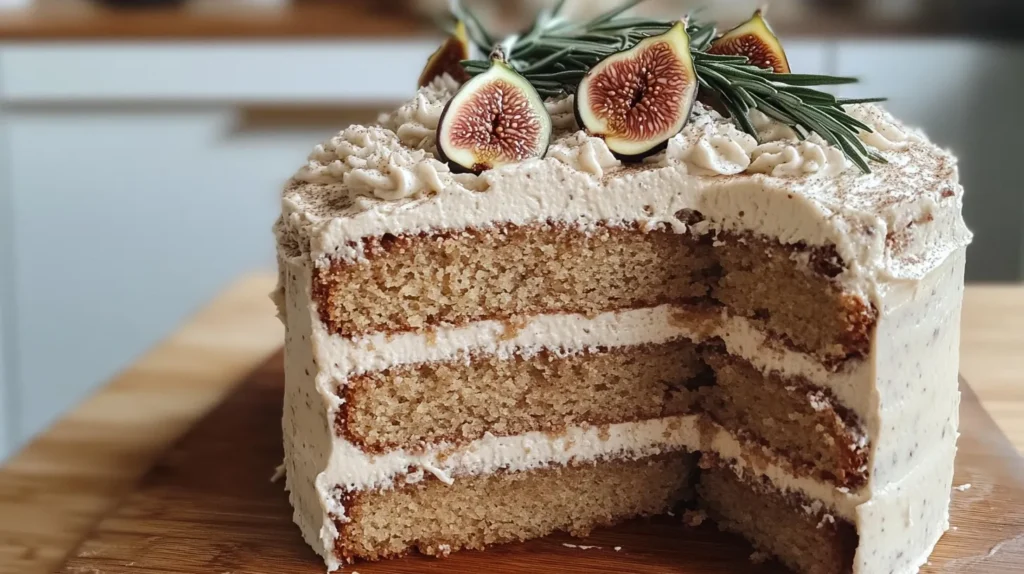
Crafting the Perfect Cinnamon Cake with Rosemary and Fig
The foundation of this cake lies in its thoughtfully layered components. Each element plays a role in enhancing texture, flavor, and moisture, ensuring a perfectly balanced bite.
1. The Cinnamon Olive Oil Sponge: A Moist and Fragrant Base
Unlike traditional butter-based cakes, this recipe uses olive oil, which not only keeps the sponge tender but also enhances the depth of flavor. The addition of Ceylon cinnamon brings warmth and a hint of spice. This sponge is further enriched with a brown sugar cake soak, ensuring every layer remains soft and flavorful.
2. The Role of the Brown Sugar Cake Soak
A simple mixture of brown sugar and water, this soak helps intensify the caramel-like sweetness in the sponge. Once baked, the cake layers are brushed with this syrup, allowing them to absorb extra moisture without becoming soggy. This step prevents dryness and enhances the overall experience of the cake.
3. The Rosemary-Infused Vanilla Bean Mousse: A Delicate Contrast
The light and airy mousse filling adds a subtle herbal note to the cake, preventing it from becoming overwhelmingly sweet. Fresh rosemary is steeped in heavy cream, allowing its essence to infuse into the mixture before being blended with vanilla bean paste and powdered sugar. The result is a smooth, creamy filling with a hint of earthiness that complements the spiced cake layers.
With these components working together, the cake achieves a perfect balance of spice, sweetness, and freshness. The next step is bringing it all together with the luxurious Fig Swiss Meringue Buttercream.
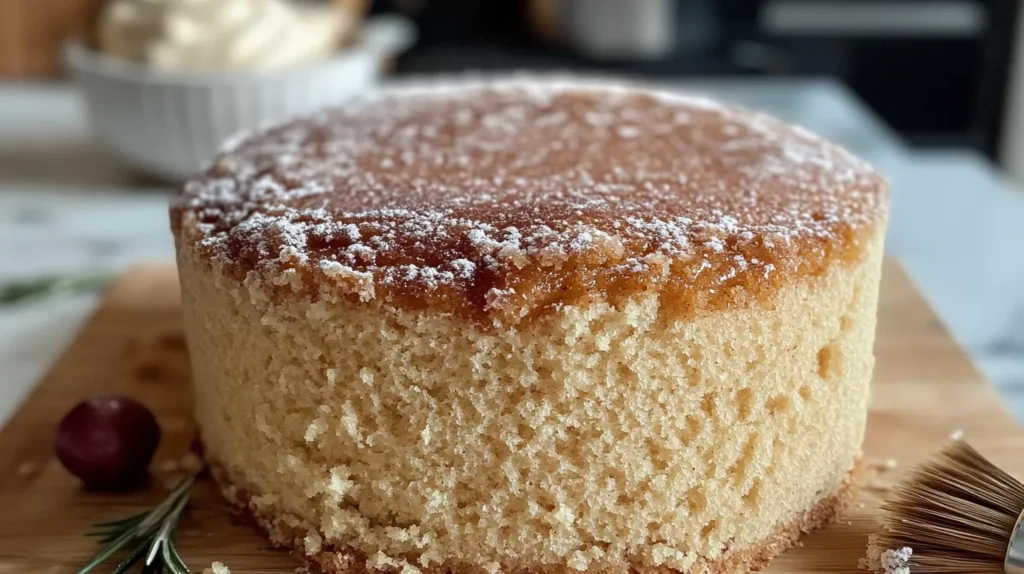
Mastering the Fig Swiss Meringue Buttercream
The final and most indulgent layer of this cake is the Fig Swiss Meringue Buttercream. This frosting adds richness while balancing the herbal and spiced notes of the cake. Unlike traditional buttercreams, Swiss meringue buttercream is smooth, silky, and less sugary, making it the perfect base for incorporating fig preserves.
1. The Art of Swiss Meringue Buttercream
Swiss meringue buttercream is made by whisking egg whites and sugar over a double boiler until the sugar dissolves. This mixture is then whipped into stiff peaks before gradually incorporating butter. The result is a light, creamy frosting that holds its shape while remaining soft and easy to spread.
2. Incorporating the Fig Preserves
Fig preserves are blended into the buttercream to add depth and natural sweetness. The preserves break down into the frosting, creating a slightly chunky texture. For a smoother finish, the preserves can be blended and strained before adding them to the buttercream.
3. Achieving the Perfect Balance
- For a chunkier texture: Use fig preserves as they are, allowing small bits of fruit to remain in the frosting.
- For a smoother texture: Blend and strain the preserves before mixing them into the buttercream.
- Flavor adjustments: Cinnamon is added to the frosting to enhance the spice notes of the cake, ensuring a harmonious taste from sponge to frosting.
This buttercream doesn’t just complement the cake—it elevates it, creating a luxurious, well-balanced finish. With the cake layers ready and the frosting perfected, it’s time for the final touches.
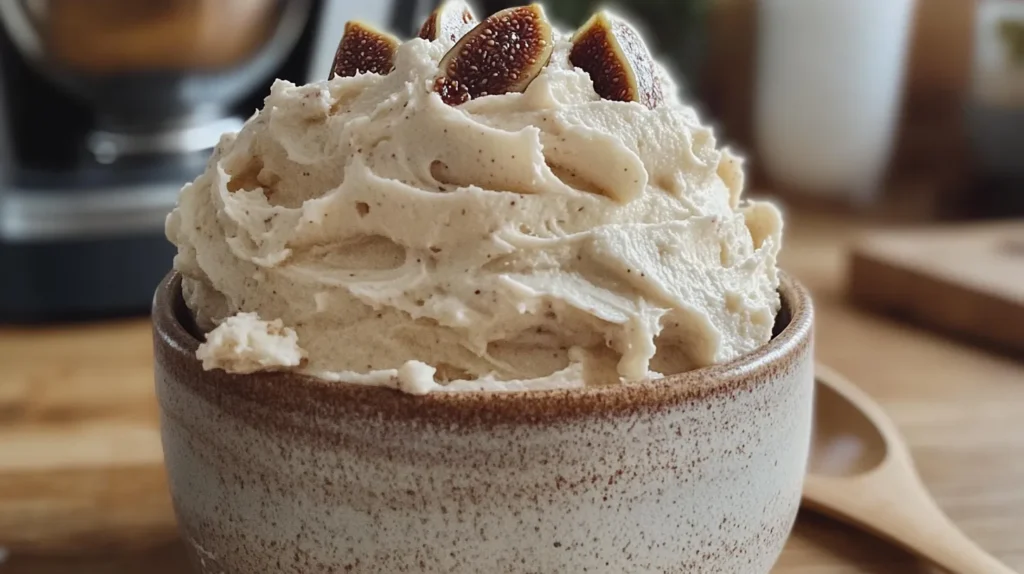
Decorating and Serving Suggestions
The final step in creating the Cinnamon Cake with Rosemary and Fig is its presentation. A beautifully decorated cake enhances the overall experience, making it just as visually appealing as it is delicious.
1. Crumb Coating and Frosting the Cake
Before applying the final layer of buttercream, it’s essential to crumb coat the cake. This step locks in crumbs and provides a smooth surface for decorating.
- Apply a thin layer of buttercream around the entire cake.
- Chill the cake for 15 minutes to set the crumb coat.
- Spread a final layer of buttercream, smoothing it with an offset spatula for a clean finish.
2. Creative Garnishing Ideas
To enhance the natural flavors and elegance of the cake, consider the following decorations:
- Fresh rosemary sprigs – A simple yet sophisticated touch that hints at the herbal infusion in the mousse.
- Sugared red grapes – A unique alternative to traditional cake toppings, adding a delicate crunch and a sparkling effect.
- Extra fig preserves or sliced fresh figs – Placed on top or around the base for added visual appeal and a burst of fruitiness.
- Cinnamon dusting – A light sprinkle over the top of the cake enhances the warm spice notes.
3. Best Beverage Pairings
To fully appreciate the flavors of this cake, pair it with a complementary drink:
- Herbal teas (such as chamomile or cinnamon-infused blends) enhance the rosemary and spice notes.
- Spiced lattes or chai tea bring out the warmth of the cinnamon.
- Dessert wines like a sweet Riesling or a fig-infused port elevate the fruity and rich elements of the cake.
This cake isn’t just a dessert—it’s an experience, blending sophisticated flavors with an elegant presentation. Whether served for a special occasion or as a seasonal treat, it’s sure to impress.
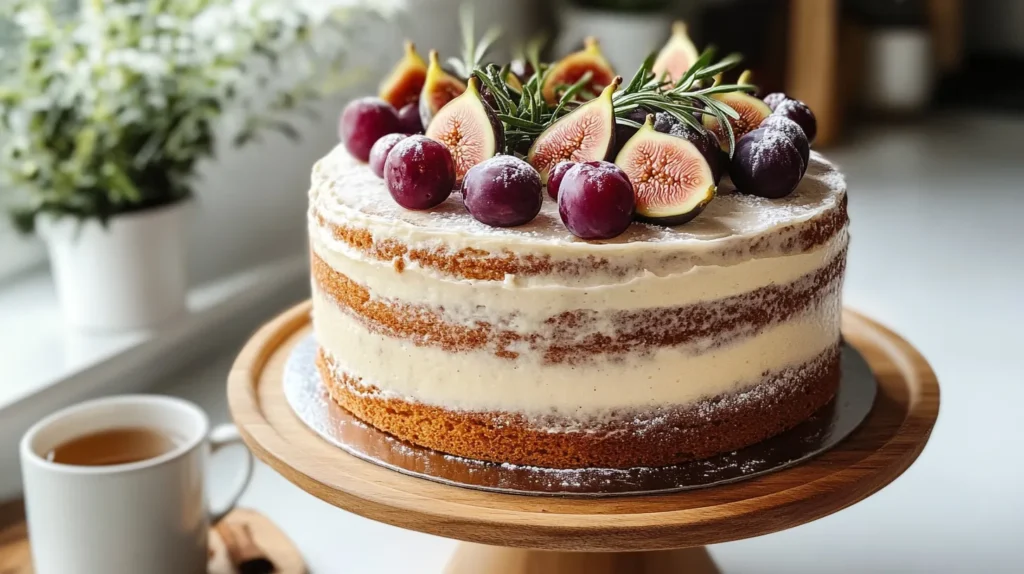
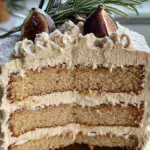
Cinnamon Cake with Rosemary & Fig
- Total Time: 5 hours 10 minutes
- Yield: 10 slices 1x
Description
This cinnamon-infused olive oil sponge cake is brushed with a brown sugar soak, layered with a rosemary-infused vanilla bean mousse, and frosted with a cinnamon-fig Swiss meringue buttercream. A perfect balance of warm spice, herbal notes, and fruity sweetness.
Ingredients
For the Cake:
- 1 batch Vanilla Bean Olive Oil Cake
- 50 g granulated sugar
- 3 tablespoons ground cinnamon
For the Cake Soak:
- 1/2 cup brown sugar
- 1/2 cup water
For the Mousse:
- 3/4 cup heavy cream
- 2–3 sprigs fresh rosemary
- 2 teaspoons vanilla bean paste
- 2 tablespoons powdered sugar
- 3/4 teaspoon unflavored gelatin powder
- 1 tablespoon water
For the Buttercream:
- 1 batch Swiss Meringue Buttercream
- 3/4 cup good quality fig preserves
- 2 tablespoons ground cinnamon
Instructions
For the Cake:
- Whisk sugar and cinnamon into the dry ingredients of the cake batter.
- Bake the cake as per the recipe instructions.
- Let cool completely before assembling.
For the Cake Soak:
- Combine brown sugar and water in a microwave-safe bowl.
- Microwave for 1-2 minutes until sugar fully dissolves.
- Refrigerate until needed.
For the Mousse:
- Heat heavy cream with rosemary sprigs over medium-high heat until just below boiling.
- Remove from heat and let cool to room temperature.
- Transfer to a container, refrigerate, and let infuse for several hours or overnight.
- Strain out rosemary before using.
- Bloom gelatin by sprinkling it over water and letting it sit for 5 minutes.
- Whip chilled rosemary-infused cream with vanilla bean paste and powdered sugar until soft peaks form.
- Microwave gelatin for 5-10 seconds until melted (do not boil).
- Slowly stream melted gelatin into whipped cream while beating on high until stiff peaks form.
- Refrigerate for at least an hour.
For the Buttercream:
- Prepare Swiss meringue buttercream as per recipe.
- Fold in fig preserves and cinnamon after butter is incorporated.
- Adjust salt to taste.
Assembly:
- Place the first cake layer on a cake board.
- Brush liberally with cake soak and let absorb for a minute.
- Spread a thin layer of buttercream over the cake.
- Beat mousse to fluff it up, then spread an even layer over the buttercream.
- Add the second cake layer and repeat the soaking and layering steps.
- Place the final cake layer, brush with cake soak, and let absorb.
- Spread a thin crumb coat of buttercream over the entire cake.
- Refrigerate for 15 minutes until set.
- Apply a second coat of buttercream, smoothing as desired.
- Decorate with piped buttercream, fresh rosemary, and sugared grapes if desired.
Notes
- Storage: Keep in an airtight container in the fridge for up to 3 days. Bring to room temperature before serving.
- Variations: Use honey instead of brown sugar in the soak for a floral twist.
- Pairing Suggestions: Serve with herbal tea or a spiced latte for the perfect cozy pairing.
- Prep Time: 1 hour 30 minutes
- Cook Time: 40 minutes
- Category: Dessert
- Cuisine: Modern, Seasonal
Nutrition
- Calories: 450
Frequently Asked Questions (FAQ)
u003cstrongu003eDoes rosemary go with cinnamon?u003c/strongu003e
Yes, rosemary and cinnamon complement each other well. The warm spice of cinnamon pairs beautifully with the earthy, slightly piney notes of rosemary, creating a balanced and aromatic flavor profile.
u003cstrongu003eWhat does cinnamon do to a cake?u003c/strongu003e
Cinnamon enhances the flavor of a cake by adding warmth and subtle sweetness. It also deepens the overall aroma, making the cake more inviting and comforting.
u003cstrongu003eHow much cinnamon should you add to a cake?u003c/strongu003e
The amount of cinnamon depends on the recipe and personal preference. Typically, 1 to 3 tablespoons of ground cinnamon is sufficient for a well-balanced flavor without overpowering other ingredients.
Conclusion
Cinnamon Cake with Rosemary and Fig is a sophisticated and flavorful dessert that perfectly balances warm spices, herbal notes, and natural sweetness. The combination of cinnamon, rosemary, and fig creates a unique and memorable taste experience, making this cake ideal for special occasions or as a comforting treat. With its carefully crafted layers and though.

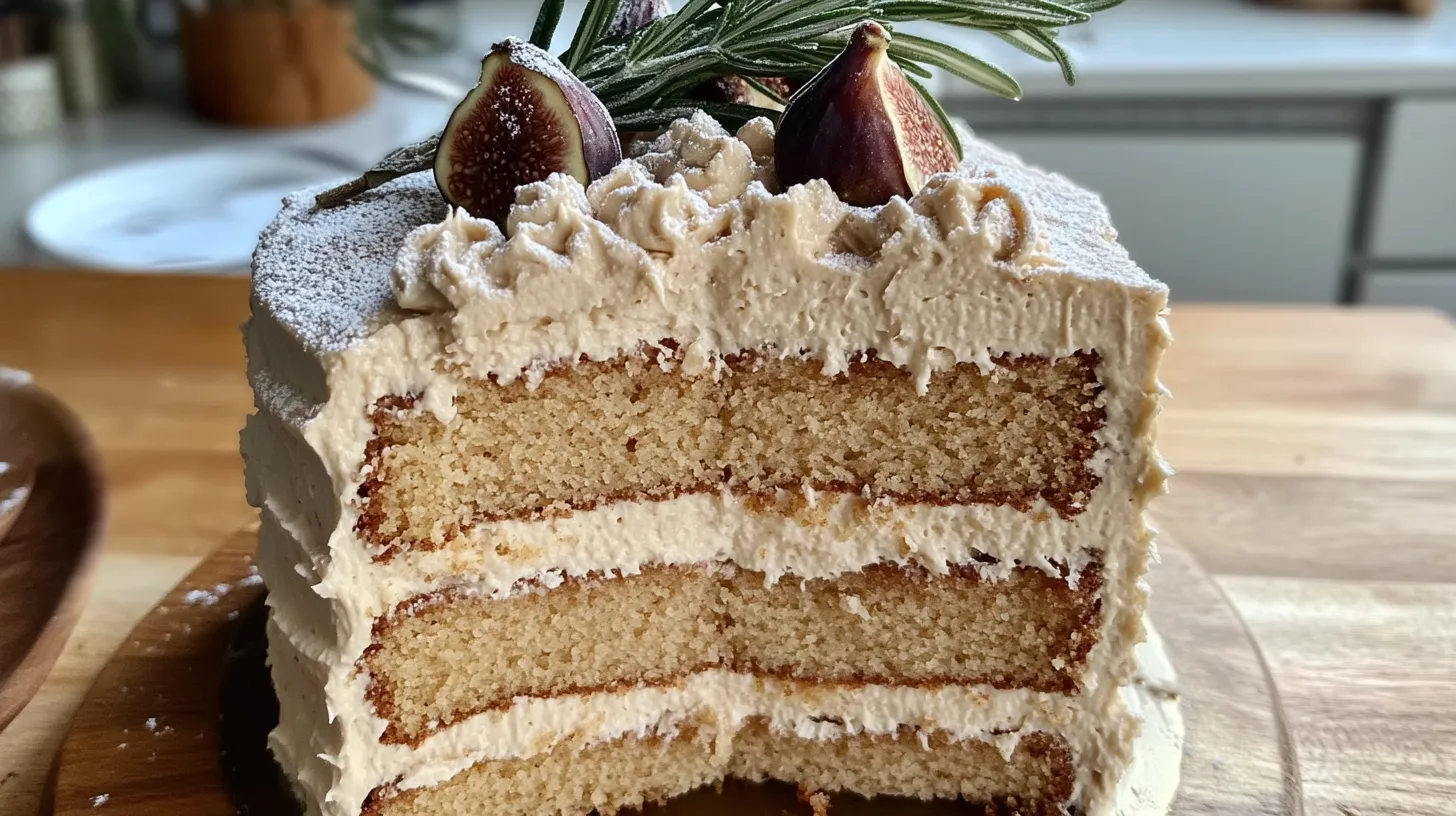

Definitely a new favorite!
Yummy